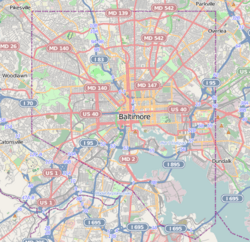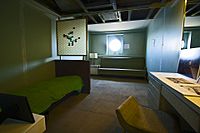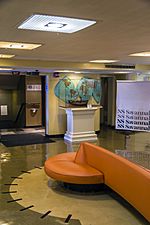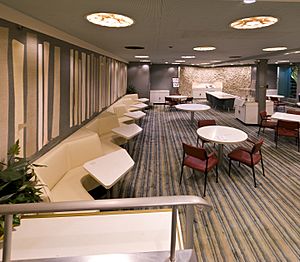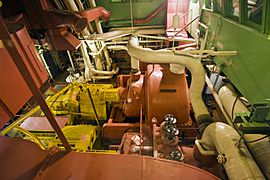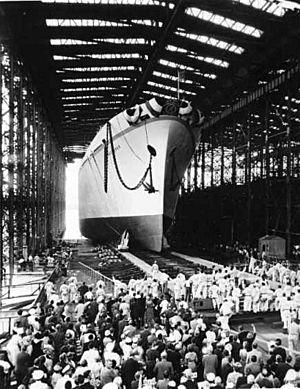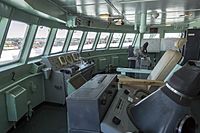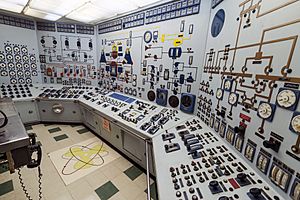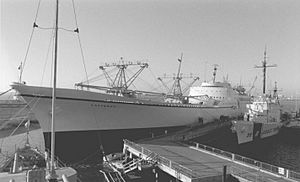NS Savannah facts for kids

NS Savannah reaching the Golden Gate Bridge in 1962
|
|
| History | |
|---|---|
| Owner | US Maritime Administration |
| Operator |
|
| Port of registry | Savannah |
| Ordered | 1955 |
| Builder | New York Shipbuilding Corporation, Camden, New Jersey, United States |
| Cost | $46,900,000 ($18,600,000 for the ship, and $28,300,000 for the nuclear plant and fuel) |
| Yard number | 529 |
| Launched | July 21, 1959 |
| Sponsored by | Mamie Eisenhower |
| Completed | December 1961 |
| Acquired | May 1, 1962 |
| Maiden voyage | August 20, 1962 |
| In service | 1964 |
| Out of service | January 10, 1972 |
| Identification |
|
| Status | Museum ship |
| General characteristics | |
| Type | Nuclear-powered cargo ship |
| Tonnage | 13,599 gross register tons (GRT); 9,900 long tons deadweight (DWT) |
| Length | 596 ft (181.66 m) |
| Beam | 78 ft (23.77 m) |
| Installed power | One 74 MW Babcock & Wilcox nuclear reactor powering two De Laval steam turbines |
| Propulsion | 20,300 hp (15,100 kW) (designed) single shaft |
| Speed |
|
| Range | 300,000 nmi (560,000 km; 350,000 mi) at 20 knots (37 km/h; 23 mph) on one single load of 32 fuel elements |
| Capacity |
|
| Crew | 124 |
|
Savannah (nuclear ship)
|
|
| Nearest city | Baltimore, Maryland |
| Built | 1961 |
| Architect | George G. Sharp, Inc.; New York Ship Building Corporation |
| NRHP reference No. | 82001518 |
| Significant dates | |
| Added to NRHP | November 14, 1982 |
| Designated NHL | July 17, 1991 |
The NS Savannah was a very special ship. It was the first merchant ship in the world to be powered by a nuclear reactor. Built in the late 1950s, it cost about $46.9 million. A big part of that cost, $28.3 million, was for its nuclear reactor and fuel. The United States government paid for the ship.
The Savannah was launched on July 21, 1959. It was a project to show how nuclear energy could be used for peaceful things. The ship was named after the SS Savannah, which was the first steamship to cross the Atlantic Ocean. The NS Savannah was used from 1962 to 1972. It was one of only four nuclear-powered cargo ships ever built. (The Soviet ice-breaker Lenin, launched in 1957, was actually the first nuclear-powered civilian ship.)
The Savannah stopped being used in 1971. After moving a few times, it has been docked in Baltimore, Maryland, since 2008. It is now a Museum ship.
Contents
How the NS Savannah Began
In 1955, President Dwight D. Eisenhower had an idea. He suggested building a nuclear-powered merchant ship. This ship would be a symbol for his "Atoms for Peace" plan. This plan was about using atomic power for good things, not just for weapons.
The next year, the U.S. Congress approved the Savannah project. It was a team effort between the Atomic Energy Commission, the Maritime Administration (MARAD), and the Department of Commerce.
The ship was designed by a company called George G. Sharp, Incorporated, from New York City. Its keel (the bottom structure of the ship) was laid down by the New York Shipbuilding Corporation in Camden, New Jersey. The Babcock & Wilcox company made the ship's nuclear reactor. On July 21, 1959, the ship was launched and named by U.S. First Lady Mamie Eisenhower.
In 1969, the Savannah made history. It became the first nuclear-powered ship to dock in New York City. This was a big event called "Nuclear Week In New York." Many people visited the Savannah and learned about peaceful uses of atomic energy. They saw things like food kept fresh by radiation and new technologies. Even the TV show The Tonight Show Starring Johnny Carson talked about "Nuclear Week In New York."
The Idea Behind the Ship
President Eisenhower wanted a "peace ship." He hoped it would show the world how atomic power could be used for good. He said the ship was not meant to make money. Instead, it was meant to spread goodwill around the world.
The Savannah was designed to be a commercial ship. Its power system was made for everyday use, not for military purposes. This was a clear choice to keep it separate from military programs.
George G. Sharp, Inc., designed almost everything on the Savannah. Only the nuclear reactor was designed by Babcock & Wilcox. The Savannah was one of the first large ships to have fin stabilizers. These fins helped make the ride smoother for passengers and kept the reactor safer.
The reactor was in the middle of the ship. It needed clear space above it for refueling. Because of this, the main part of the ship (the superstructure) was placed far back. The ship's unique, sleek shape was designed to look futuristic. It even had cool atom designs on its sides! The inside of the ship also had a modern "Atomic Age" style.
About the NS Savannah
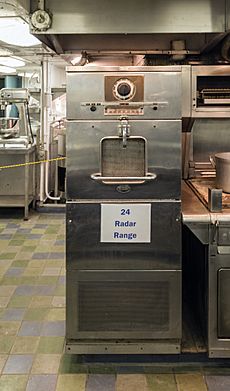
The Savannah is about 596.5 feet (181.8 m) long and 78 feet (24 m) wide. When fully loaded, it sits 29.5 feet (9.0 m) deep in the water. It weighs 21,800 tons when loaded. The ship has seven cargo areas, a reactor area, and a machinery area. These nine areas are sealed off to prevent water from getting in. There are three full decks on the ship. The reactor is near the center, and the main ship structure is just behind it. This allows the reactor to be refueled from above.
The top deck has the pilothouse (where the ship is steered), the radio room, and other important areas. The deck below has rooms for the ship's officers. Below that is the promenade deck. This deck has a large lounge, stairs, an elevator, and a veranda lounge. There was even a bar with glass walls looking out over a swimming pool. The lounge had a dance floor and tables with glowing glass tops. The bar area featured a cool metal sculpture of the periodic table of the elements.
"A" Deck is the first full deck. It has areas for handling cargo at the front and back. The inside of "A" Deck has the main lobby, the purser's office, and a health lab to check for radiation. All 30 passenger cabins are on "A" Deck. Each cabin had its own bathroom and could hold one to three people.
"B" Deck has the ship's kitchen and dining room. The dining room could seat 75 people. It has a curved wall sculpture called "Fission." There's also a metal model of the SS Savannah in a glass panel. The lights in the ceiling look like stylized atoms. The kitchen even had an early microwave oven. "B" Deck also has living areas for the crew.
"C" Deck has more crew quarters and a laundry room. A glassed-in area lets you see the main engine room. A special door leads to the upper parts of the reactor area.
"D" Deck holds the machinery, cargo areas, and the nuclear reactor itself.
The Reactor

The Savannah's reactor was built for civilian use. It used low-enriched uranium. The main focus was on safety and being dependable, not on being small or able to withstand shocks like military reactors.
The reactor was placed so it could be refueled from above. It's a tall, narrow cylinder, inside a larger containment vessel. This vessel is about 50-foot (15 m) long. It holds the pressurized-water reactor, the cooling system, and the steam generator. The steel walls of the vessel are very thick, from 2.5 inches (6.4 cm) to 4 inches (10 cm). This helps it handle pressure if a pipe breaks.
The lower part of the containment vessel is protected by a 4-foot (1.2 m) thick concrete shield. The upper part has 6 inches (15 cm) of lead and 6 inches (15 cm) of polyethylene for protection. The sides of the vessel are shielded by layers of 1-inch (2.5 cm) steel and 3-inch (7.6 cm) of redwood.
The reactor was taken out of service in 1975, but it's still inside the ship. The reactor is 17 feet (5.2 m) high. It has 32 fuel elements, each about 0.5 inches (1.3 cm) wide. These elements contain uranium oxide pellets. There are 21 control rods, which can be fully inserted in just 1.6 seconds.
The Machinery
The main machinery room is 55 feet (17 m) long, 78 feet (24 m) wide, and 32 feet (9.8 m) high. The main control room is right behind it. From here, engineers controlled both the reactor and the steam engines. A window separates the control room from the machinery room. Visitors could see the control room from a viewing area on "C" Deck.
The steam plant is like a normal steam engine. It has turbines that turn a single propeller shaft. These turbines were specially made to use the steam from the nuclear reactor. The ship also had a 750 horsepower electric motor. This motor could be used in an emergency to help move the ship. It could even move the ship away from a pier if there was a reactor problem.
The ship was designed to produce 20,000 horsepower (15,000 kW) and go 20 knots (37 km/h; 23 mph). But it actually performed even better! It produced about 22,000 hp (16,000 kW) and could reach a top speed of 24 knots (44 km/h; 28 mph).
Why Nuclear Power Was Special
The Savannah was built to show that nuclear power could work for merchant ships. It wasn't expected to make a lot of money. It was designed to look amazing, more like a fancy yacht than a cargo ship. It had 30 air-conditioned staterooms, a dining room for 100 people, a lounge, a swimming pool, and a library. Even its cargo equipment looked good!
The ship was a success in many ways. It worked well at sea, and it had a great safety record. Its bright white paint never got dirty from exhaust smoke, because it didn't burn fuel oil. From 1965 to 1971, the Maritime Administration rented the Savannah to a company called American Export-Isbrandtsen Lines to carry cargo.
However, the Savannah could only carry about 8,500 tons of cargo. Many other ships could carry much more. Its sleek shape made it hard to load cargo in the front. This became a problem as ports became more modern. The ship also needed a larger crew than regular ships. The crew needed special training for the nuclear reactor. There were also disagreements about how much the nuclear engineers should be paid. Because of these issues, the Savannah cost about $2 million more each year to operate than a regular ship.
In 1971, the Maritime Administration decided to stop using the ship to save money. At that time, fuel oil was cheap. But by 1974, fuel oil prices went up a lot. If the Savannah had still been running then, its costs would have been similar to a regular cargo ship.
Taking Care of the Nuclear Ship
When the Savannah first started operating, it released a lot of very low-level radioactive waste into the ocean. To help with this, a special barge called the Atomic Servant was built. This barge could take waste from the Savannah anywhere in the world.
When the reactor was shut down in 1975, the radioactive water and some parts were removed. By 2005, the remaining radioactivity in the ship had greatly decreased. In 2011, the radiation levels were very low. The reactor and the ship will be managed until 2031 to ensure safety.
The Ship's Journey
After its naming ceremony on July 21, 1959, it took two and a half more years to get the reactor ready. The ship was then moved to Yorktown, Virginia, where the reactor was started and tested. The reactor reached full power in April 1962. On May 1, 1962, the Savannah was given to the Maritime Administration and its first operators, States Marine Lines.
Its first trip began on August 20, 1962. The Savannah sailed to its home port of Savannah. During this trip, a small problem with an instrument caused the reactor to shut down. This was wrongly reported as a big accident in the news. From there, it went through the Panama Canal and visited Hawaii and ports on the west coast. It was a popular exhibit for three weeks at the Century 21 Exposition in Seattle.
In early 1963, the ship arrived in Galveston, Texas, for repairs. Here, there was a disagreement about how much the nuclear engineers should be paid. This led to a strike by the crew and the reactor being shut down. The contract with States Marine Lines was canceled, and a new operator, American Export-Isbrandtsen Lines, was chosen. A new crew had to be trained.
By 1964, the Savannah began a tour of U.S. Gulf and East Coast ports. That summer, it crossed the Atlantic Ocean for the first time. It visited cities like Bremerhaven, Hamburg, Rotterdam, Dublin, and Southampton. About 150,000 people visited the ship during this tour.
The Savannah carried both passengers and cargo until 1965, when passenger service stopped. By then, it had carried 848 passengers and 4,800 tons of cargo. The ship was then changed to carry only cargo. It operated for three more years and traveled 350,000 miles (560,000 km) before returning to Galveston for refueling. It continued service until the end of 1971, when it was taken out of use.
During its time in service, the Savannah traveled 450,000 miles (720,000 km). It visited 45 foreign ports and 32 U.S. ports. About 1.4 million people visited the ship as part of the "Atoms for Peace" project. The Savannah's visits also helped make it easier for nuclear-powered navy ships to visit foreign ports. However, the ship was not allowed in ports in Australia, New Zealand, and Japan.
After it was taken out of service, the City of Savannah tried to make it a floating hotel. But they couldn't find investors. For a short time in the late 1970s, it was stored in Galveston, Texas.
The Savannah as a Museum Ship
In 1981, the Savannah was moved to the Patriots Point Naval and Maritime Museum in Mount Pleasant, South Carolina. Visitors could tour the cargo areas, see the engine room, look into the staterooms, and walk on the decks.
The museum hoped to fix up the ship's public areas, but these plans didn't happen. The Savannah didn't attract as many visitors as the museum's other ships, like the aircraft carrier Yorktown. In 1993, an inspection showed the Savannah needed repairs. So, in 1994, the ship was moved from the museum to a dry dock in Baltimore, Maryland, for repairs. After that, it was moved to the James River Merchant Marine Reserve Fleet in Newport News, Virginia.
The Maritime Administration has not yet paid to remove the ship's nuclear systems. The Savannah had some repairs in 2006, including fixing the outside structure and lighting. On May 8, 2008, the Savannah arrived in Baltimore. It is still in Baltimore today.
In September 2019, the NS “Savannah” was towed to Philadelphia for maintenance and early work to prepare for decommissioning. This work includes removing nuclear support systems and other parts before the reactor itself is removed. The decommissioning must be finished by 2031. By February 2020, the ship had returned to Baltimore.
The Savannah is a very important historical ship. It has been named a National Historic Landmark. The Maritime Administration wants to offer the ship for preservation once all the nuclear work is done. They hope it will become a museum, but no one has offered to take on the project yet.
A Historic Ship
The Savannah was added to the National Register of Historic Places on November 14, 1982. It was named a National Historic Landmark on July 17, 1991. The Savannah is important because it's one of the best examples of the "Atoms for Peace" program. It was given this special honor even though it wasn't 50 years old yet, because it was so important to the nation's history.
See also
 In Spanish: NS Savannah para niños
In Spanish: NS Savannah para niños


